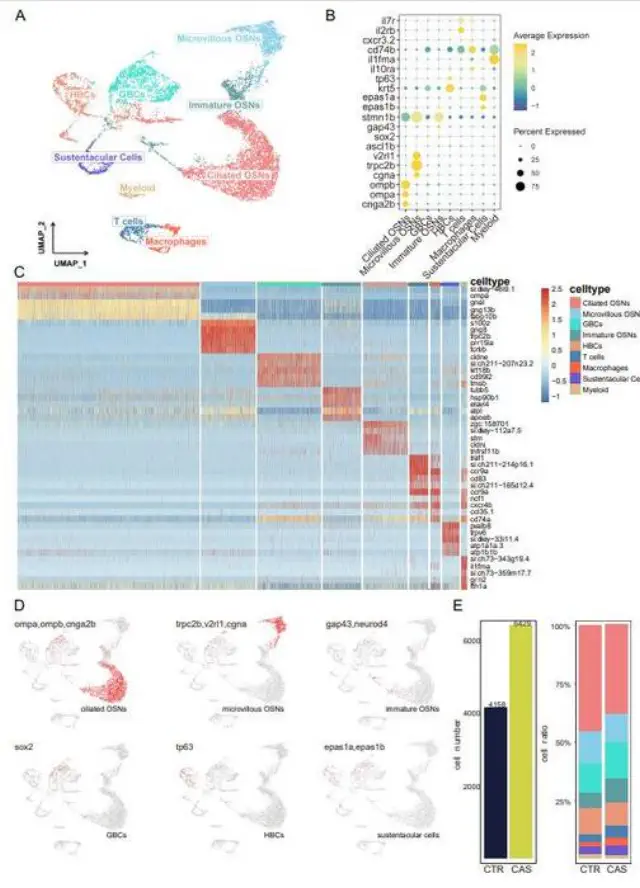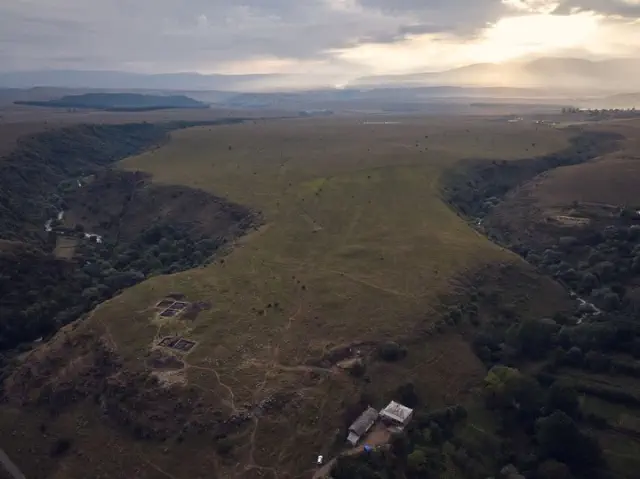
Groundbreaking Technique Reveals Fish Sense of Smell
View pictures in App save up to 80% data. Recent research has revealed significant new findings about the cellular structure and functional processes of the zebrafish olfactory epithelium, utilizing cutting-edge single-cell RNA sequencing technology. This advanced genomic technique offers an unparalleled view into the complex architecture and molecular characteristics of individual cell types within the zebrafish's olfactory system, a species renowned for its remarkable sense of smell. Led by a distinguished group of scientists from China, the study highlights the cellular variety present in the olfactory epithelium, identifying nine unique cell types that each play specialized roles in the chemical detection linked to zebrafish behavior. Zebrafish, known scientifically as Danio rerio, are widely recognized as key model organisms in the fields of neurobiology and behavioral studies. Their advanced olfactory system is vital for mediating essential survival behaviors such as feeding, selecting mates, and evading predators. In their study, researchers set up a control group alongside a group exposed to conspecific alarm substances (CAS)—chemical signals emitted by injured fish that elicit a startle reaction in others. This targeted approach enabled the researchers to explore the potential adaptability of cell populations within the olfactory epithelium when faced with environmental stressors. By employing single-cell sequencing techniques, the researchers were able to delineate a range of cell types within the olfactory epithelium of zebrafish, which included both immature and mature olfactory sensory neurons (OSNs), horizontal basal cells, and sustentacular cells. Furthermore, they identified immune cells such as lymphocytes and myeloid cells that exhibit critical immune signaling, highlighting the relationship between the sense of smell and immune function. The research team conducted an advanced clustering analysis that unveiled unique transcriptional profiles for each cell type, showcasing a significant degree of cellular diversity that had not been thoroughly investigated before. A particularly significant element of the research focused on assessing how CAS influences transcriptional dynamics in the olfactory epithelium of zebrafish. Subsequent analyses revealed marked alterations in the ratios of different cell types and certain populations of olfactory sensory neurons (OSNs). The lead author, Wenjun Chen, expressed that the study's results indicate that CAS exposure may trigger apoptosis in OSNs, leading to a reduction in their overall numbers. This reduction initiates a compensatory response, activating OSN progenitor cells to restore the diminished sensory neuron population, thereby underscoring the adaptability of the olfactory system. This research broadens our comprehension of how fish cells react to chemical signals, especially when under stress. While earlier studies suggested that teleost fishes harbor various cell types, this investigation offers a more precise and comprehensive view. The importance of this work extends beyond simply identifying different cell types; it also demonstrates how these cellular populations adaptively respond to environmental stimuli, which could have significant repercussions for our understanding of sensory biology and ecological dynamics. Additionally, the results reveal promising directions for future investigations into the genetic and functional characteristics of these cell types in different environmental and ecological contexts. This underscores the necessity of examining not just the cellular makeup of ecological systems such as zebrafish, but also the dynamic interactions of these cells in reaction to both internal and external factors. Such a holistic perspective allows researchers to broaden their studies to encompass wider ecological and evolutionary frameworks. Within the realms of conservation biology and environmental sustainability, exploring olfactory plasticity in reaction to chemical signals holds significant importance. This understanding can shed light on how fish populations adjust to alterations in their environments, especially when pollutants or other stressors disrupt standard chemical communication pathways. The zebrafish model serves as an excellent basis for deeper research into these critical matters, providing essential knowledge that could lead to practical ecological solutions in the real world. In conclusion, the research led by Wenjun Chen and his team marks a notable advancement in the realm of cellular biology, especially concerning sensory systems. The utilization of precision single-cell sequencing technology has transformed our capacity to analyze the complex molecular mechanisms governing cellular interactions in the zebrafish olfactory system. These comprehensive insights into cellular operations may pave the way for future biomedical innovations, potentially steering regenerative medicine approaches and therapeutic solutions aimed at addressing olfactory impairments. As researchers delve deeper into the intricacies of sensory biology using advanced methodologies, the zebrafish model emerges as an essential resource for comprehending both fundamental biological concepts and the practical dimensions of fisheries science and environmental health. The significance of these discoveries reaches far beyond the confines of academic research and laboratory experiments, influencing conservation projects and ecosystem management strategies that strive to maintain biodiversity in aquatic habitats. To sum up, the progress demonstrated in this study emphasizes the integration of technology and biology in unraveling the intricate workings of sensory systems and their adaptive mechanisms. The continuous investigation of the zebrafish olfactory epithelium stands out as an intriguing example, showcasing how model organisms can provide valuable insights into wide-ranging biological inquiries that hold importance for society. Subject of Research: Animals Article Title: Single-cell RNA sequencing of zebrafish olfactory epithelium reveals cellular heterogeneity and responses to a conspecific alarm substance News Publication Date: October 2023 Web References: DOI link References: Scientific Journal Article Image Credits: Wenjun Chen, et al Keywords: Bioinformatics, Developmental biology, Genetics, Freshwater biology, Organismal biology Explore additional insights from the world of Science. Sign up to receive the newest updates directly in your inbox.

SpaceX continues to deploy additional Starlink satellites, maintaining its momentum as it heads into 2024.
View pictures in App save up to 80% data. On Wednesday, a SpaceX Falcon 9 rocket lifted off from Launch Complex 39 at the Kennedy Space Center in Florida, successfully deploying Starlink satellites as part of Mission 12-11. Image courtesy of Joe Marino/UPI | License Photo. Jan. 8 (UPI) -- Coming off a record-setting 2024, SpaceX continued an aggressive launching schedule with the liftoff Wednesday morning of a Falcon 9 rocket that carried 21 Starlink satellites into lower-Earth orbit. The launch from Kennedy Space Center took place at 10:27 a.m. EST with a first-stage booster making its third trip. The booster landed on the drone ship A Shortfall of Gravitas in the Atlantic Ocean about eight minutes after liftoff. According to SpaceX, 13 of the newly launched satellites are equipped with direct-to-cell technology. Starlink is the largest satellite constellation ever deployed, designed to make Internet service available globally regardless of how remote the designation. According to satellite tracker and astrophysicist Jonathan McDowell, there are more than 6,850 active Starlink satellites orbiting Earth currently. SpaceX ended 2024 with 134 successful launches, a new record after just missing 100 launches in 2023. SpaceX successfully sends 21 Starlink satellites into orbit. View pictures in App save up to 80% data. On January 8, 2025, a SpaceX Falcon 9 rocket successfully lifts off from Launch Complex 39 at Kennedy Space Center in Florida, carrying a payload of Starlink satellites. Photo credit: Joe Marino/UPI | Licensed Image.

Dietert News – January 8, 2025
Happy New Year! As we welcome 2025, it arrives with a chill in the air and freezing temperatures. Looking for a fantastic spot to enjoy lunch and spend quality time with good friends in a cozy atmosphere? Look no further than Dietert! The Friendship Cafe kicks off at 11 a.m., serving delicious lunches from 11:30 a.m. to 12:30 p.m. It's the perfect venue to meet new people or treat your pals to a delightful meal. You may just discover your new favorite hangout for the year ahead. With plenty of activities happening, there’s something for everyone to enjoy!

ISS National Lab Unveils Funding Opportunity of Up to $650,000 for Advancements in Low Earth Orbit Technology
KENNEDY SPACE CENTER, Fla., Jan. 8, 2025 /PRNewswire/ -- The International Space Station (ISS) National Laboratory is soliciting flight concepts for technology advancement that utilizes the space-based environment of the orbiting laboratory. This solicitation, "Technology Advancement and Applied Research Leveraging the ISS National Lab," is open to a broad range of technology areas, including chemical and material synthesis in space, translational medicine, in-space edge computing, and in-space servicing, assembly, and manufacturing. It also encompasses the application of space station remote sensing data to improve geospatial analytics for commercial use. The development and demonstration of space-based technologies is a key strategic focus for the ISS National Lab. This initiative offers a chance to fast-track technology maturation, potentially leading to innovations that enhance human life and foster commercial activities in low Earth orbit (LEO). In this research announcement, participants are invited to leverage the distinctive setting of the orbiting platform to innovate, refine, or advance products and processes that show promise for generating immediate and beneficial economic effects, either directly or indirectly. Concepts for flights chosen through this announcement may receive financial support to facilitate mission integration and operational assistance for initiatives intended for execution on the space station. Key focus areas for this solicitation encompass, but are not restricted to: Hardware prototype testing: Innovations addressing hardware product development gaps and emerging technology proliferation in the areas of electronics; semiconductors; nanotechnologies; robotics; sensors; and communications, remote sensing, computer, and satellite technology. Process improvements: Use of the space station as a test bed to advance the development of facilities for high-throughput investigations or to demonstrate new methodologies for spaceflight research and development, or the use of space-based data to facilitate modeling of industrial systems. Advanced materials: Current advanced materials research that addresses the development of next-generation production methods, testing of novel materials, and the exploitation of materials with unique properties. Translational medicine: Validation of accelerated disease modeling, analyzing macromolecular structures for drug design, and demonstration of novel drug delivery and diagnostic services. As an example, on SpaceX's most recent Commercial Resupply Services mission for NASA to the space station, Kall Morris Inc., launched a project funded through a prior ISS National Lab technology development solicitation. The project is testing the REACCH capture system for space debris removal using the Astrobees, free-flying autonomous robots on the space station, bringing the capture system closer to commercialization. The system could reduce risk to current space-based infrastructure and clear orbital slots for future infrastructure. This research announcement will follow a two-step proposal submission process. Before being invited to submit a full proposal, all interested investigators must submit a Step 1: Concept Summary for review. The Center for the Advancement of Science in Space™, manager of the ISS National Lab, will host a webinar on Thursday, January 23, at 1 p.m. EST to discuss space station facilities and capabilities associated with this research announcement. Register in advance at the link. Step 1: All Concept Summaries need to be submitted by the close of business on March 3, 2025. Step 2: Full Proposals from selected invitees must be submitted by the end of the day on May 19, 2025. It is anticipated that several projects will receive funding through this research announcement, with a total funding pool of up to $650,000. For more information about this opportunity, including how to submit a Step 1: Concept Summary, please visit the research announcement webpage. To learn more about the ISS National Lab and the science that it sponsors, please visit our website. Download a high-resolution image for this release: Astronaut Suni Williams Works With Astrobee Information on the International Space Station (ISS) National Laboratory:The International Space Station (ISS) is a one-of-a-kind laboratory that enables research and technology development not possible on Earth. As a public service enterprise, the ISS National Laboratory® allows researchers to leverage this multiuser facility to improve quality of life on Earth, mature space-based business models, advance science literacy in the future workforce, and expand a sustainable and scalable market in low Earth orbit. Through this orbiting national laboratory, research resources on the ISS are available to support non-NASA science, technology, and education initiatives from U.S. government agencies, academic institutions, and the private sector. The Center for the Advancement of Science in Space™ (CASIS®) manages the ISS National Lab, under Cooperative Agreement with NASA, facilitating access to its permanent microgravity research environment, a powerful vantage point in low Earth orbit, and the extreme and varied conditions of space. To learn more about the ISS National Lab, visit our website. As a 501(c)(3) nonprofit organization, CASIS® accepts corporate and individual donations to help advance science in space for the benefit of humanity. For more information, visit our donations page. Media Contact: Patrick O'Neill 904-806-0035 International Space Station (ISS) National LaboratoryManaged by the Center for the Advancement of Science in Space, Inc. (CASIS) 1005 Viera Blvd., Suite 101, Rockledge, FL 32955 • 321.253.5101 • www.ISSNationalLab.org

Today's Highlights: January 8, 2025
View pictures in App save up to 80% data. Heading out to play in the snow is fun for everyone, but it's important to remain safe, so TidalHealth is with us to share the best way to enjoy the weather. For All Seasons is marking ten years of providing mental health services, advocacy, and education, we help them celebrate. We're learning how the Lower Shore Autism Community is helping those on the spectrum live richer, fuller lives, and previewing their upcoming event. The freezing weather can have hazardous effects on your home, so Delaware Electric Cooperative brings us tips to avoid any damage. We head to Funfull to discover how active fun is a cherished hobby at their massive trampoline park. James McDonald is enjoying the snowy weather outside, creating snow angels and sharing his favorite winter pastimes with us. Tune in to DelmarvaLife today at 5 PM!

Archaeologists Baffled by 3,000-Year-Old Mountain "Mega Fortress" and Its Enigmatic Purpose
The location was discovered to be 40 times larger than what was originally estimated. View pictures in App save up to 80% data. Dmanisis Gora was surrounded by a double set of fortified walls. Photo credit: Nathaniel Erb-Satullo. A massive Bronze-Age "mega fortress" has been uncovered in the Caucasus mountains, intriguing researchers who are trying to determine the role of this monumental prehistoric site at the junction of Europe and Asia. Dubbed Dmanisis Gora, this expansive fortified settlement overshadows all surrounding fortifications, but offers scant evidence regarding its inhabitants. Dated to around 3,000 years ago, Dmanisis Gora is one of many fortress settlements that appeared in the South Caucasus between the second and first millennia BCE. Following initial excavations at the site in Georgia in 2018, archaeologists were surprised when they returned the following year to find the remains of a second set of fortification walls surrounding the inner fortress, thus massively expanding the size of the settlement. Dmanisis Gora is so vast that it cannot be fully appreciated from the ground level; only drone photography can capture its true extent. In total, researchers captured 11,000 aerial images of the location, which they combined to create a comprehensive representation of the fortress. “The results of this survey showed that the site was more than 40 times larger than originally thought, including a large outer settlement defended by a 1-kilometer-long [0.6-mile] fortification wall,” explained study author Dr Nathaniel Erb-Satullo in a statement. “These datasets enabled us to identify subtle topographic features and create accurate maps of all the fortification walls, graves, field systems, and other stone structures within the outer settlement.” According to the researchers, the inner and outer fortification walls were “mutually dependent with respect to defence,” meaning they functioned as one system of protective barriers and neither wall could be considered impenetrable without the other. They were also both constructed in the same style, using rough boulders assembled without the use of mortar into walls roughly 2 meters (6.6 feet) thick. View pictures in App save up to 80% data. An image depicting the exterior fortification wall, accompanied by power lines for reference in scale. Photo credit: Nathaniel Erb-Satullo. The results indicate that both fortifications were constructed concurrently, implying that the inner and outer settlements functioned as components of a single extensive site. "Should our hypothesis that the inner fortress and outer settlement were approximately contemporaneous be accurate, this settlement would rank among the largest recognized in the South Caucasus during the Late Bronze and Iron Age," the authors of the study state. Interestingly, the vast outer settlement appears to lack significant archaeological finds, indicating that it may not have been home to a large population or was deserted soon after its construction. Both possibilities raise questions, especially considering the considerable effort invested in constructing the fortified walls. Offering a possible explanation, researchers suggest that the fortress may have been used seasonally, potentially as a staging ground by pastoralists during the spring and autumn. Such a hypothesis would appear to justify the importance placed on this key site despite the fact that it lacked a large permanent population. At this time, the specific purpose behind the site's establishment continues to be unclear. Nevertheless, Erb-Satullo mentions that "additional research will soon shed light on aspects like population density and intensity, livestock movements, and farming methods, among other factors." The study is published in the journal Antiquity.